THE BEGINNING OF THE HILLSIDE PARISH
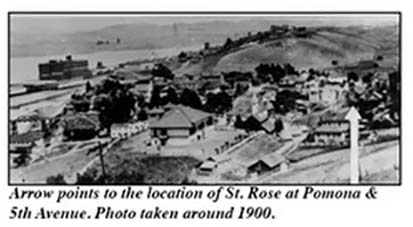
Our corner of the Oakland Diocese was served for the first 360 years as part of Spain and Mexico by the Franciscans and Dominicans. When California became part of the United States, the men of the Dominican Order of Preachers cared for the early Catholic settlers. Since becoming a parish in 1912 we have seen tended by the Dominicans for 11 years, by Diocesan priests for 32 years, and, for the last 45 years, by the men of the Missionary Oblates of Mary Immaculate founded by St. Eugene de Mazenod. We have a very rich history, tied as we are to early exploration, missions, pioneers, and immigrants from nearly every corner of the earth.
Long before the coming of the Dominicans, the people of the Carquinez where tended by Franciscan priests from Mexico. In 1776, Juan Bautista de Anza brought his small body of explorers up the eastern shore of the Bay with Father Pedro Font as the expedition’s chronicler. Twenty-one years later Father Lasuen, successor to Blessed Father Junipero Serra, dedicated Mission San Jose on June 11, 1797. The Mission had all of the area which became Contra Costa and Alameda counties within its “zone of influence”. When Bishop Joseph Sadoc Alemany, O.P., arrived in Monterey in 1850, he presided over a diocese stretching from Baja California to the Oregon border and from the Rocky Mountains to the Pacific Ocean. In 1853, Pope Plus IX approved the division of the Diocese of California and named Alemany to be the first Archbishop of San Francisco and the spiritual shepherd for Roman Catholics in California north of Monterey. Fr. Francis Sadoc Villarrasa, O.P., came to Monterey as Alemany’s companion in establishing the Dominican order in California. By 1854, Father Villarrasa decided to move the Order to Benicia and the Dominicans received the parishes of Benicia and Martinez with their churches, an area encompassing most of Solano and parts of Contra Costa counties.
From their church in Benicia, the Dominican Fathers cared for the many pioneer faithful on both sides of the Carquinez Straits. In the late 1870’s, after the coming of the railroad, Port Costa was focus of shipping California wheat to Europe and Asia. Warehouses lined the shore and at the peak of the grain season there could be as many as 3000 men, predominately Irish, working on the waterfront. Without a church, Mass was held wherever space could be obtained. For example, as reported in the Contra Costa Gazette of Sept. 15, 1883, “Mass was celebrated and a sermon preached last Sunday by Rev. Father Dyson, O.P., of Benicia. The dining room at Crowley and Casey’s boarding house in Port Costa was arranged as a temporary chapel for the service, and was completely filled by a very orderly and attentive audience.” The first St. patrick’s Church was built on two lots donated by entrepreneur George W. McNear of which the San Francisco Monitor reported: “It is built on a picturesque knoll in the beautiful valley and forms a striking object among the rural residences already built there in considerable numbers.” The church was a frame building, 55 by 36 feet, designed “in the early pointed style of the thirteenth century.” And had seating capacity of 200 persons and a total cost of $1500. The new building was dedicated on Sunday, Feb 3rd, 1884 with Archbishop P.W. Riordan assisting Father Dyson. The Archbishop’s sermon was titled “The Catholic Church” and he spoke for “upwards of an hour.” Music was provided by the young ladies choir of St. Catherine’s Academy in Benicia.” The first building served the community for 14 years when it became necessary for Fathr Francis Sadoc Welch, O.P., to build the present St. Patrick’s Church. The San Francisco Monitor reported that Port Costa “would soon have a new house of worship because the present church built in 1883 is being torn down to be replaced by a larger edifice.” Designed by Rev. Raymond Johns, O.P., a trained architect from the Dominican’s English province, the church in Gothic Style was completed in 1898 at a cost of $7,000. About 1890 the Catholic population of Valona, now part of Crockett, began talking about building their own church and establishing a new parish. From time to time a priest from Benicia would come to a Valona home for home liturgy or to Crockett where Father Albert Lawler, O.P., would say mass in a hall. By January, 1892, Father Lawler heeded the wishes of local communicants and began collecting money for the construction of a building on a lot at the head of Port Street. Although not yet completed, on Christmas Day 1892, with a board resting across two barrels as an altar, the first mass was celebrated in the new St. Rose building. Six months later, on July 2, 1893, the Church was formally dedicated with all the pomp and ceremony attendant on an event of this significance. Immigrant families kept arriving, and, as was the custom of the day, families were large. Weddings, baptism, CCD classes and confirmations by the hundreds made it obvious that this little building could not accommodate the needs of the parish. By 1907, Father Thompson and his building committee began looking at alternatives. Early in 1908 a decision was made to build a new church. The lot at 4th Ave. and Starr St. (currently the parking lot) was donated by C & H. The anticipated cost of $10,000 was too much money for the young community. The decision was made to move the old church to the new location and enlarge it to provide more seating and a basement area for a church hall. Father E. B. Kenney, O.P., became the pastor, a parish house was constructed, and Archbishop Riordan journeyed across the Bay to confirm the 1912 class. St. Rose was established as a parish in its own right and no longer looked to St. Patrick’s, Port Costa as the parent church. Irish, Italian, Portuguese and Spanish were deeply rooted in the faith and prayerful in their habits, as well as regular in church attendance. They were hard-working, be it at the waterfront and warehouses, on the ranches, places of business, or providing services. The parish and parish organizations provided a “center” for their life. During these early years the Ancient Order of Hibernians and the Portuguese I.D.E.S. were formed and provided activities for the people of the area. In later years the I.C.F. was formed. Father Edward B. Kenny, O.P. was Pastor from 1912 to 1916. The Dominican Sisters from Vallejo taught catechism. After Father Kenny the Dominican Priests, Frs. Alfred Meagles, A. Lamb and J.G. Rourke, served as pastors until 1923. The historic days of the Dominicans in Crockett and Port Costa came to an end in 1923 when Father Andrew J. Carroll was appointed pastor by the Diocese of San Francisco. Well-known for his eloquence, Father Carroll was energetic in the administration of the parish. Among other things, he purchased the entire block of property in front of the church (where the present church is located), with the hope for a parochial school in the future. His associate Pastor was Father Geoffrey Gilman, who was destined to remain under three successors: Father Edward J. Kelly, Father Peter Doyle, and Father Albert R. Bandini, K.S.G. who was appointed pastor in 1932. A distinguished litterateur, a member of the Bar association, a musician and composer, mastermind of the Italian Catholic Federation, and Translator of Dante’s Divine Comedy, Fr. Bandini would shepherd the parish for the next 14 years. Shortly after his arrival, Father Bandini organized a well-known choir under the direction of Bernard McKeown, with Mrs. Mae Jacobs as Organist. For special occasions this choir was requested in other parishes. Parish groups flourished: the Holy Name Society, the Archdiocesan Council of Catholic Women, the Catholic Youth Organization, and, of course, the Italian Catholic Federation. The Holy Family Sisters came from San Francisco two and often three times a week to teach the ever-growing number of children. In 1930 Archbishop Hanna confirmed a class of 130. The children thronged their 9 A.M. Mass on Sundays, Parish Missions in English and Italian were conducted with remarkable success. The stage was set for the reconstruction and renovation of St. Rose and Father Bandini undertook the renovation with vigor. The result was a striking gem in the hillside parish, its bell tower modeled after the famous one on the Town Hall-Pelazzo della Signoria of Florence. In 1946 Father Bandini was succeeded by Father Anthony F. Morrissey; next came Father Henry E. Plunkett, followed by Father Samuel Tarrant, and, finally, Father Raymond Daly, a zealous convert-maker and brilliant instructor. The year 1954 was marked with the worldwide celebration of a Marian Holy Year—a most appropriate and propitious time for the Oblates of Mary Immaculate to set in motion an arrangement for their Order to take over St. Rose Parish in Crockett in June, 1955. Father Francis Taylor, O.M.I., with Fr. William McHugh as assistant were the first of their members to be appointed to St. Rose. Fr. Maurice Smith, O.M.I. was pastor from 1958 to 1971. In 1963 a fire in the church set in motion plans to build a new church. The property purchased by Father Carroll in 1923 became the sit for the new and current church. In the meantime through the kindness of Donato “Toots” Pezzuto, the old Lanai Theater at the corner of Starr St. and 2nd Ave. was transformed into a temporary church. It served the people of Crockett until the present attractive and spacious parish plant was built and dedicated on September 24, 1967. This stands today as a monument to the faith and generosity of its parishioners, and to the leadership of Father Smith, O.M.I. The following Oblates have served as pastors, Fathers Joseph Scales, O.M.I. from 1971 to 1974, Gerald J. Gottenbos, O.M.I. from 1974 to 1982, and Paul Nourie, O.M.I., from 1982 to 1985, Paul Maher, O.M.I. from 1985 to 1993 followed by Claran Dilion, O.M.I. the longest tenure of 20 years. |The beloved pastor retired on June 30, 2013 along with the Oblates, leaving its responsibility of the parish to the Oakland Diosese. Our corner of the Oakland Diocese was served for the first 360 years as part of Spain and Mexico by the Franciscans and Dominicans. When California became part of the United States, the men of the Dominican Order of Preachers cared for the early Catholic settlers. Since becoming a parish in 1912 we have been tended by the Dominicans for 11 years, by Diocesan priests for 32 years, and, for the last 45 years, by the men of the Missionary Oblates of Mary Immaculate founded by St. Eugene de Mazenod. We have a very rich history, tied as we are to early exploration, missions, pioneers, and immigrants from nearly every corner of the earth. Long before the coming of the Dominicans, the people of the Carquinez where tended by Franciscan priests from Mexico. In 1776, Juan Bautista de Anza brought his small body of explorers up the eastern shore of the Bay with Father Pedro Font as the expedition’s chronicler. Twenty-one years later Father Lasuen, successor to Blessed Father Junipero Serra, dedicated Mission San Jose on June 11, 1797. The Mission had all of the area which became Contra Costa and Alameda counties within its “zone of influence”. When Bishop Joseph Sadoc Alemany, O.P., arrived in Monterey in 1850, he presided over a diocese stretching from Baja California to the Oregon border and from the Rocky Mountains to the Pacific Ocean. In 1853, Pope Plus IX approved the division of the Diocese of California and named Alemany to be the first Archbishop of San Francisco and the spiritual shepherd for Roman Catholics in California north of Monterey. Fr. Francis Sadoc Villarrasa, O.P., came to Monterey as Alemany’s companion in establishing the Dominican order in California. By 1854, Father Villarrasa decided to move the Order to Benicia and the Dominicans received the parishes of Benicia and Martinez with their churches, an area encompassing most of Solano and parts of Contra Costa counties. From their church in Benicia, the Dominican Fathers cared for the many pioneer faithful on both sides of the Carquinez Straits. In the late 1870’s, after the coming of the railroad, Port Costa was focus of shipping California wheat to Europe and Asia. Warehouses lined the shore and at the peak of the grain season there could be as many as 3000 men, predominately Irish, working on the waterfront. Without a church, Mass was held wherever space could be obtained. For example, as reported in the Contra Costa Gazette of Sept. 15, 1883, “Mass was celebrated and a sermon preached last Sunday by Rev. Father Dyson, O.P., of Benicia. The dining room at Crowley and Casey’s boarding house in Port Costa was arranged as a temporary chapel for the service, and was completely filled by a very orderly and attentive audience.” The first St. patrick’s Church was built on two lots donated by entrepreneur George W. McNear of which the San Francisco Monitor reported: “It is built on a picturesque knoll in the beautiful valley and forms a striking object among the rural residences already built there in considerable numbers.” The church was a frame building, 55 by 36 feet, designed “in the early pointed style of the thirteenth century.” And had seating capacity of 200 persons and a total cost of $1500. The new building was dedicated on Sunday, Feb 3rd, 1884 with Archbishop P.W. Riordan assisting Father Dyson. The Archbishop’s sermon was titled “The Catholic Church” and he spoke for “upwards of an hour.” Music was provided by the young ladies choir of St. Catherine’s Academy in Benicia.” The first building served the community for 14 years when it became necessary for Fathr Francis Sadoc Welch, O.P., to build the present St. Patrick’s Church. The San Francisco Monitor reported that Port Costa “would soon have a new house of worship because the present church built in 1883 is being torn down to be replaced by a larger edifice.” Designed by Rev. Raymond Johns, O.P., a trained architect from the Dominican’s English province, the church in Gothic Style was completed in 1898 at a cost of $7,000. About 1890 the Catholic population of Valona, now part of Crockett, began talking about building their own church and establishing a new parish. From time to time a priest from Benicia would come to a Valona home for home liturgy or to Crockett where Father Albert Lawler, O.P., would say mass in a hall. By January, 1892, Father Lawler heeded the wishes of local communicants and began collecting money for the construction of a building on a lot at the head of Port Street. Although not yet completed, on Christmas Day 1892, with a board resting across two barrels as an altar, the first mass was celebrated in the new St. Rose building. Six months later, on July 2, 1893, the Church was formally dedicated with all the pomp and ceremony attendant on an event of this significance. Immigrant families kept arriving, and, as was the custom of the day, families were large. Weddings, baptism, CCD classes and confirmations by the hundreds made it obvious that this little building could not accommodate the needs of the parish. By 1907, Father Thompson and his building committee began looking at alternatives. Early in 1908 a decision was made to build a new church. The lot at 4th Ave. and Starr St. (currently the parking lot) was donated by C & H. The anticipated cost of $10,000 was too much money for the young community. The decision was made to move the old church to the new location and enlarge it to provide more seating and a basement area for a church hall. Father E. B. Kenney, O.P., became the pastor, a parish house was constructed, and Archbishop Riordan journeyed across the Bay to confirm the 1912 class. St. Rose was established as a parish in its own right and no longer looked to St. Patrick’s, Port Costa as the parent church. Irish, Italian, Portuguese and Spanish were deeply rooted in the faith and prayerful in their habits, as well as regular in church attendance. They were hard-working, be it at the waterfront and warehouses, on the ranches, places of business, or providing services. The parish and parish organizations provided a “center” for their life. During these early years the Ancient Order of Hibernians and the Portuguese I.D.E.S. were formed and provided activities for the people of the area. In later years the I.C.F. was formed. Father Edward B. Kenny, O.P. was Pastor from 1912 to 1916. The Dominican Sisters from Vallejo taught catechism. After Father Kenny the Dominican Priests, Frs. Alfred Meagles, A. Lamb and J.G. Rourke, served as pastors until 1923. The historic days of the Dominicans in Crockett and Port Costa came to an end in 1923 when Father Andrew J. Carroll was appointed pastor by the Diocese of San Francisco. Well-known for his eloquence, Father Carroll was energetic in the administration of the parish. Among other things, he purchased the entire block of property in front of the church (where the present church is located), with the hope for a parochial school in the future. His associate Pastor was Father Geoffrey Gilman, who was destined to remain under three successors: Father Edward J. Kelly, Father Peter Doyle, and Father Albert R. Bandini, K.S.G. who was appointed pastor in 1932. A distinguished litterateur, a member of the Bar association, a musician and composer, mastermind of the Italian Catholic Federation, and Translator of Dante’s Divine Comedy, Fr. Bandini would shepherd the parish for the next 14 years. Shortly after his arrival, Father Bandini organized a well-known choir under the direction of Bernard McKeown, with Mrs. Mae Jacobs as Organist. For special occasions this choir was requested in other parishes. Parish groups flourished: the Holy Name Society, the Archdiocesan Council of Catholic Women, the Catholic Youth Organization, and, of course, the Italian Catholic Federation. The Holy Family Sisters came from San Francisco two and often three times a week to teach the ever-growing number of children. In 1930 Archbishop Hanna confirmed a class of 130. The children thronged their 9 A.M. Mass on Sundays, Parish Missions in English and Italian were conducted with remarkable success. The stage was set for the reconstruction and renovation of St. Rose and Father Bandini undertook the renovation with vigor. The result was a striking gem in the hillside parish, its bell tower modeled after the famous one on the Town Hall-Pelazzo della Signoria of Florence. In 1946 Father Bandini was succeeded by Father Anthony F. Morrissey; next came Father Henry E. Plunkett, followed by Father Samuel Tarrant, and, finally, Father Raymond Daly, a zealous convert-maker and brilliant instructor. The year 1954 was marked with the worldwide celebration of a Marian Holy Year—a most appropriate and propitious time for the Oblates of Mary Immaculate to set in motion an arrangement for their Order to take over St. Rose Parish in Crockett in June, 1955. Father Francis Taylor, O.M.I., with Fr. William McHugh as assistant were the first of their members to be appointed to St. Rose. Fr. Maurice Smith, O.M.I. was pastor from 1958 to 1971. In 1963 a fire in the church set in motion plans to build a new church. The property purchased by Father Carroll in 1923 became the sit for the new and current church. In the meantime through the kindness of Donato “Toots” Pezzuto, the old Lanai Theater at the corner of Starr St. and 2nd Ave. was transformed into a temporary church. It served the people of Crockett until the present attractive and spacious parish plant was built and dedicated on September 24, 1967. This stands today as a monument to the faith and generosity of its parishioners, and to the leadership of Father Smith, O.M.I. The following Oblates have served as pastors, Fathers Joseph Scales, O.M.I. from 1971 to 1974, Gerald J. Gottenbos, O.M.I. from 1974 to 1982, and Paul Nourie, O.M.I., from 1982 to 1985, Paul Maher, O.M.I. from 1985 to 1993 followed by Claran Dilion, O.M.I. the longest tenure of 20 years. |The beloved pastor retired on June 30, 2013 along with the Oblates, leaving its responsibility of the parish to the Oakland Diosese.
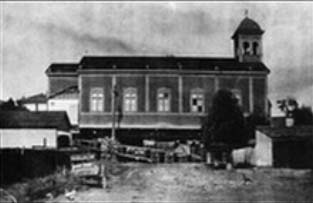
After being moved to 4th Avenue and Starr St, Raised up to build the basement
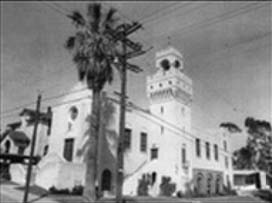
Photo of the extensive renovations undertaken by Father Bandini. Completed December 1939
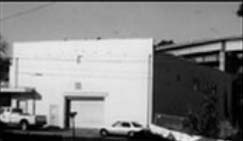
Former Lanai Theater at 2nd and Starr, used as a temporary place of worship for 4 years.
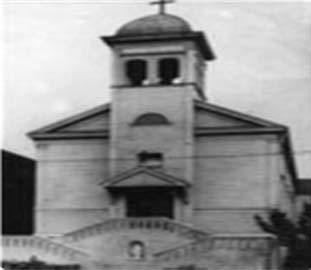
St. Rose in 1933 with new front steps management
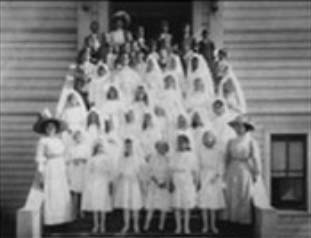
First Communition Group on the steps of St. Rose, Photo taken 1911, after it was moved to a new site at 4th and Starr.